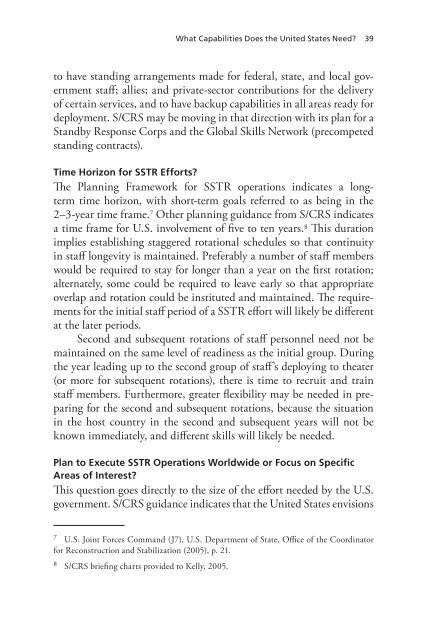Stabilization and Reconstruction Staffing - RAND Corporation
Stabilization and Reconstruction Staffing - RAND Corporation
Stabilization and Reconstruction Staffing - RAND Corporation
Create successful ePaper yourself
Turn your PDF publications into a flip-book with our unique Google optimized e-Paper software.
What Capabilities Does the United States Need? 39to have st<strong>and</strong>ing arrangements made for federal, state, <strong>and</strong> local governmentstaff; allies; <strong>and</strong> private-sector contributions for the deliveryof certain services, <strong>and</strong> to have backup capabilities in all areas ready fordeployment. S/CRS may be moving in that direction with its plan for aSt<strong>and</strong>by Response Corps <strong>and</strong> the Global Skills Network (precompetedst<strong>and</strong>ing contracts).Time Horizon for SSTR Efforts?The Planning Framework for SSTR operations indicates a longtermtime horizon, with short-term goals referred to as being in the2–3-year time frame. 7 Other planning guidance from S/CRS indicatesa time frame for U.S. involvement of five to ten years. 8 This durationimplies establishing staggered rotational schedules so that continuityin staff longevity is maintained. Preferably a number of staff memberswould be required to stay for longer than a year on the first rotation;alternately, some could be required to leave early so that appropriateoverlap <strong>and</strong> rotation could be instituted <strong>and</strong> maintained. The requirementsfor the initial staff period of a SSTR effort will likely be differentat the later periods.Second <strong>and</strong> subsequent rotations of staff personnel need not bemaintained on the same level of readiness as the initial group. Duringthe year leading up to the second group of staff’s deploying to theater(or more for subsequent rotations), there is time to recruit <strong>and</strong> trainstaff members. Furthermore, greater flexibility may be needed in preparingfor the second <strong>and</strong> subsequent rotations, because the situationin the host country in the second <strong>and</strong> subsequent years will not beknown immediately, <strong>and</strong> different skills will likely be needed.Plan to Execute SSTR Operations Worldwide or Focus on SpecificAreas of Interest?This question goes directly to the size of the effort needed by the U.S.government. S/CRS guidance indicates that the United States envisions7 U.S. Joint Forces Comm<strong>and</strong> (J7), U.S. Department of State, Office of the Coordinatorfor <strong>Reconstruction</strong> <strong>and</strong> <strong>Stabilization</strong> (2005), p. 21.8 S/CRS briefing charts provided to Kelly, 2005.
















